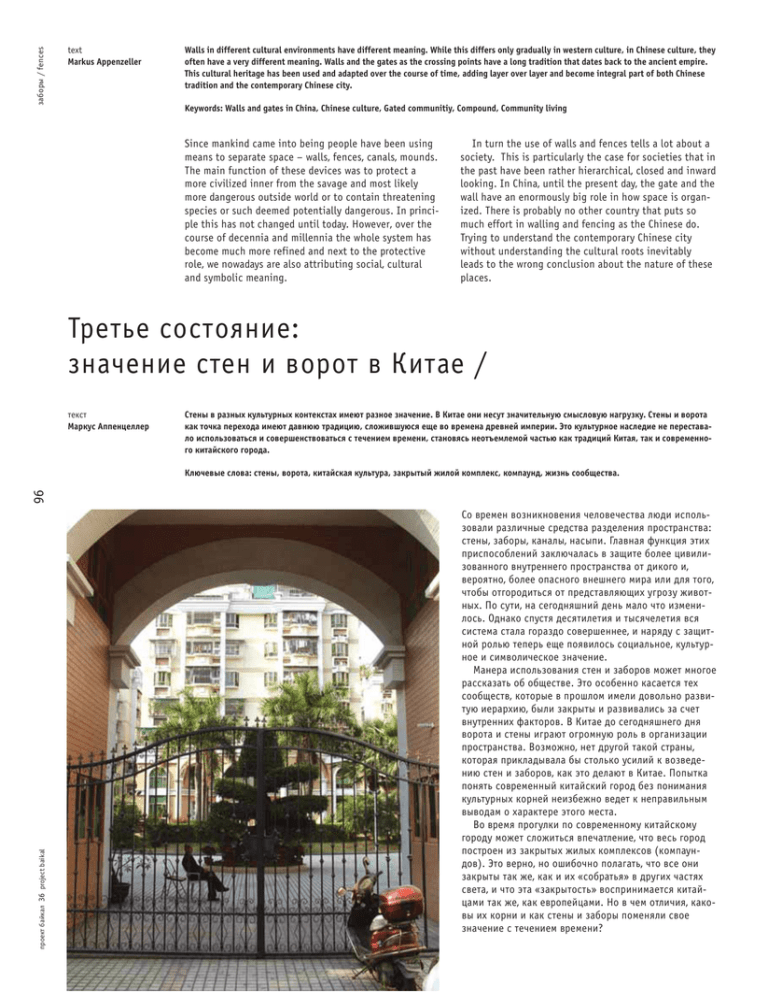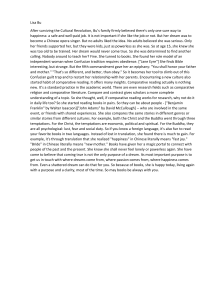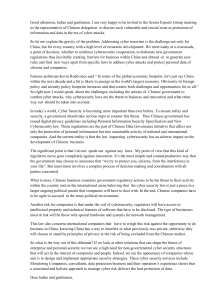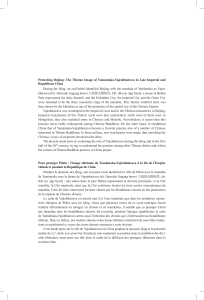Третье состояние: значение стен и ворот в Китае
реклама

заборы / fences text Markus Appenzeller Walls in different cultural environments have different meaning. While this differs only gradually in western culture, in Chinese culture, they often have a very different meaning. Walls and the gates as the crossing points have a long tradition that dates back to the ancient empire. This cultural heritage has been used and adapted over the course of time, adding layer over layer and become integral part of both Chinese tradition and the contemporary Chinese city. Keywords: Walls and gates in China, Chinese culture, Gated communitiy, Compound, Community living Since mankind came into being people have been using means to separate space – walls, fences, canals, mounds. The main function of these devices was to protect a more civilized inner from the savage and most likely more dangerous outside world or to contain threatening species or such deemed potentially dangerous. In principle this has not changed until today. However, over the course of decennia and millennia the whole system has become much more refined and next to the protective role, we nowadays are also attributing social, cultural and symbolic meaning. In turn the use of walls and fences tells a lot about a society. This is particularly the case for societies that in the past have been rather hierarchical, closed and inward looking. In China, until the present day, the gate and the wall have an enormously big role in how space is organized. There is probably no other country that puts so much effort in walling and fencing as the Chinese do. Trying to understand the contemporary Chinese city without understanding the cultural roots inevitably leads to the wrong conclusion about the nature of these places. Третье состояние: значение стен и ворот в Китае / текст Маркус Аппенцеллер Стены в разных культурных контекстах имеют разное значение. В Китае они несут значительную смысловую нагрузку. Стены и ворота как точка перехода имеют давнюю традицию, сложившуюся еще во времена древней империи. Это культурное наследие не переставало использоваться и совершенствоваться с течением времени, становясь неотъемлемой частью как традиций Китая, так и современного китайского города. проект байкал 36 project baikal 96 Ключевые слова: стены, ворота, китайская культура, закрытый жилой комплекс, компаунд, жизнь сообщества. Со времен возникновения человечества люди использовали различные средства разделения пространства: стены, заборы, каналы, насыпи. Главная функция этих приспособлений заключалась в защите более цивилизованного внутреннего пространства от дикого и, вероятно, более опасного внешнего мира или для того, чтобы отгородиться от представляющих угрозу животных. По сути, на сегодняшний день мало что изменилось. Однако спустя десятилетия и тысячелетия вся система стала гораздо совершеннее, и наряду с защитной ролью теперь еще появилось социальное, культурное и символическое значение. Манера использования стен и заборов может многое рассказать об обществе. Это особенно касается тех сообществ, которые в прошлом имели довольно развитую иерархию, были закрыты и развивались за счет внутренних факторов. В Китае до сегодняшнего дня ворота и стены играют огромную роль в организации пространства. Возможно, нет другой такой страны, которая прикладывала бы столько усилий к возведению стен и заборов, как это делают в Китае. Попытка понять современный китайский город без понимания культурных корней неизбежно ведет к неправильным выводам о характере этого места. Во время прогулки по современному китайскому городу может сложиться впечатление, что весь город построен из закрытых жилых комплексов (компаундов). Это верно, но ошибочно полагать, что все они закрыты так же, как и их «собратья» в других частях света, и что эта «закрытость» воспринимается китайцами так же, как европейцами. Но в чем отличия, каковы их корни и как стены и заборы поменяли свое значение с течением времени? The wall and the gate: Me, the collective & society To understand the difference between the gated community western style and the compound in China, one has to dig deep into the constitution of Chinese society. Western society knows the dualism between the individual and society as the sum of individuals. The domain of the individual or the family is private; the space of society is public. What’s in between – we tend to call it semi-private – has never been formalized and therefore is a big problem for planners and designers. Chinese have found a formal expression for that third category: the collective. Collective is not a sharply defined group of people but generally goes beyond the western definition of ‘friends’, neighbours or colleagues. The collective is much more organized and infiltrates many more layers of life. Collectives spend a lot of time with each other, parts of a collective do business together and protect and help each other. Spatially organizing the individual, the collective and society results in one additional level of separation. Also the hierarchy of importance differs from the western order of importance. To Chinese the collective and the spaces that come with it are the environments considered of a higher value than the public. The collective spaces are spaces of meaning, the public space is less important. Navigating through a Chinese city, one typically does заборы / fences Walking in the contemporary Chinese city one can get the impression that the entire city is constructed of gated communities. That is correct, but it is a big mistake to conclude that all of them are gated in the same way their ‘sisters’ are in other parts of the world and that this ‘gatedness’ is perceived the same way by Chinese as it is through western eyes. But where are the differences and what are the roots of these differences and how have walls and fences changed their meaning over time? Стена и ворота: я, коллектив и общество Чтобы понять разницу между западным и китайским типом закрытого жилого комплекса, нужно заглянуть поглубже в устройство китайского общества. Западному обществу знаком дуализм индивида и общества как совокупности индивидов. Пространство индивида или семьи имеет частный характер, а пространство общества – общественный. Пространство между ними – мы обычно называем его полуотдельным – никогда не было формализовано и поэтому составляет большую проблему для проектировщиков и дизайнеров. Китайцы же нашли формальное определение этой категории – коллективное. У коллектива нет строгого обозначения, оно обычно выходит за рамки западного представления о друзьях, соседях или коллегах. Коллектив гораздо более организован и охватывает намного больше пластов жизни. Члены коллектива проводят много времени друг с другом, ведут совместный бизнес, оказывают защиту и помощь друг другу. Пространственная организация индивида, коллектива и общества приводит к образованию дополнительного уровня разделения. Кроме того, иерархия ценностей в Китае отличается от европейской. Для китайца коллективное пространство ценится выше, чем общественное. Коллективное пространство имеет значение, общественное же не так важно. Прогуливаясь по китайскому городу, обычно не замечаешь разделения между частным и коллективным миром. Переход от общественного пространства к коллективному традиционно обозначен стенами. Такое разделение проектируется с акцентом на символизм и статус, безопасность же играет роль второстепенную. Появляется необходимость определить то место в v Picture 1: Outer wall of a Hutong in Beijing / Наружная стена хутонга в Пекине (A. Alexander and others: Beijing Hutong Conservation Study, International Housing Federation, 2004, P. 8) < Picture 2: Wall and gate of a contemporary compound in Shantou, Guangdong Province / Стена и ворота современного компаунда в Шаньтоу, провинция Гуандун. Фото автора 97 The Third Condition the meaning of walls and gates in China заборы / fences 98 v Picture 3: Private & Public in Western and Chinese culture / Частное и общественное в западной культуре и культуре Китая. Рисунок автора not get to experience the division between private and collective worlds. Formalized walls typically mark the transition from the public space to the collective environment. This division is designed with a focus on symbolism and status, security is secondary. Walls create the need to define places to enter and exit – the gates. Artificially reducing permeability exaggerates the importance of the transition point from inside to outside and introduces a degree of symbolism. Consequently gates in the Chinese context are designed with extra effort to draw attention – craftsmanship, colour, scale, choice of material and layout all together are employed to achieve a maximum effect and to demonstrate the ambition and affluence of the collective that can be found behind it. Entering via a gate into a collective space is not equivalent to entering into the individual’s private space, it rather means accessing the sphere of people that, as a collective, share similar interests – socially or economically. It is remarkable that walls and gates have developed over several thousands of years and today still play such an important role. They have shown a remarkable adaptability and utility and in the contemporary Chinese city gates and walls are an overlay of all these adaptations – they represent the ancient Middle Kingdom in the same way as they represent the China of today. In a way they are Chinese history in a nutshell: стене, где будет вход и выход, то есть ворота. Искусственно сниженная проходимость подчеркивает важность точки перехода изнутри наружу и добавляет некоторую степень символизма. Следовательно, особые усилия при создании ворот в китайском контексте направлены на привлечение внимания: мастерство исполнения, цвет, масштаб, выбор материала и дизайна – все это нацелено на получение максимального эффекта, демонстрацию амбиций и достатка того коллектива, который живет по ту сторону стены. Проход через ворота на территорию коллектива не означает проникновение в частное пространство индивида, это скорее доступ в круг людей, которые как единый коллектив разделяют общие социальные и экономические интересы. Интересно отметить, что стены и ворота развивались несколько тысячелетий, но и сегодня не перестают играть очень важную роль. Они всегда демонстрировали замечательные свойства приспособляемости и практичности. В современном китайском городе ворота и стены стоят на вершине всех этих адаптаций, представляя одновременно древнюю Срединную империю и современный Китай. Они нечто вроде китайской истории, изложенной в двух словах. The Great Wall, the emperor’s palace and the private house – a subsidiary principle In the long history of China, walls have always played a key role in defining and protecting territory. The extent and the scale of walls have been unique. The Roman Empire tried to protect its territory by constructing the Limes Wall which was supposed to protect against the Великая стена, дворец императора и частный дом – дополнительный принцип Всю многовековую историю Китая стены играли ключевую роль обозначения и защиты территории. Уникальны протяженность и масштаб стен. Римская Древнекитайский город – город микрокосмов На примерах старых китайских городов видно, что город – это территория, окруженная стеной. Внутри стен планировочная система позволяет быстро передвигаться из одного места в другое. Общая планировка имеет схожие черты с другими древними городами, от Мексики до Греческой империи. Здесь отчетливо видна универсальная военная логика. Но там, где на плане других городов прямоугольную форму образуют здания, в древнекитайском городе кварталы вновь огорожены стенами, за которыми живут разные слои общества. В этих стенах отчетливо обозначены ворота, обеспечивающие доступ со всех четырех сторон света. Здесь, скрытые от улицы, формировались самостоятельные микрокосмы, которые не только защищали личное, делая его частью коллективного, но также осуществляли контроль благодаря авторитарному режиму. Различные городские кварталы закрывались в ночное заборы / fences Old representations of Chinese cities show cities as a territory surrounded by a wall. Inside the walls a utilitarian grid allows for quick movement from one place to another. The overall layout has remarkable parallels with ancient cities elsewhere, from Mexico to the Greek Empire. There apparently seems to be a universal military logic to this layout. But where the rectangles of the grid are buildings elsewhere, in the old Chinese city, the city blocks are walls again within which the different groups of society were allocated. These wards had clearly marked entrances with gates in all four points of the compass. Invisible from the street, they formed self-sufficient microcosms that not only protected the individual in making it part of a collective but also enabled the authoritarian rule to maintain control. The different city blocks were closed at night time and functioned as ‘tem- < Picture 4: Community Kitchen in a Lilong compound in Shanghai / Общая кухня в компаунде Лилонг в Шанхае (culinarybackstreets.com) 99 империя пыталась защитить свою территорию, построив оборонительные валы, которые должны были оградить ее от варварских племен Северной Европы. То же самое касается Китая и монгольских племен, но, в отличие от Римской империи, которая взаимодействовала с внешним миром и была нацелена на экспансию, Китай построил Великую стену, которая в дополнение ко всему играла роль идеологическую. Это была граница, где заканчивались политические интересы Китая, и внимание было обращено лишь на внутреннее состояние дел. Такая самодостаточность была возможна лишь при политическом руководстве, которое осуществляло строгий контроль над территорией. Это достигалось при помощи высокоразвитой иерархической системы должностных лиц и повиновения императору – мудрому и всеведущему властителю, подражание которому считалось знаком почтения. Такое отношение можно было найти во всех сторонах жизни: не удивительно, что традиционный частный дом в Китае во многом был похож на маленькую копию императорского дворца, включая довольно загадочный и строгий внешний вид и более эклектичный интерьер. The ancient Chinese city – a city of microcosms < Picture 5: Elderly and kids entertaining each other in a compound in Shanghai / Совместные развлечения пожилых людей и детей в компаунде Шанхая (flickr.com/photos/7830239@N06) < Picture 6: Alley and Courtyards in Xing Cheng / Переулок и дворы в Син Чэн (D. Hassenpflug: The Urban Code of China, Birkhäuser, Basel 2010, P. 57) проект байкал 36 project baikal uncivilized northern European tribes. The same is true for China and the Mongolian tribes but unlike the Emporium Romanum, that remained outward looking and focussed on expansion, the Great Wall of China also was an ideological wall – a border that marks the point where Chinese interest stopped and a line from which the view only goes inward. This self-sufficiency was only possible by a political leadership that exercised strict control over the territory. This was achieved by a highly developed hierarchical system of civil servants and the orchestration of the emperor as the wise and omniscient leader who to copy way the biggest reverence. This can be found in all aspects of life and therefore it is not a surprise that the traditional private Chinese house in many ways tries to be a small copy of the emperor’s palace – including the rather hermetic and sober exterior and a more eclectic world inside. заборы / fences проект байкал 36 project baikal 100 porary prisons’ that helped keeping the population in check and avoiding uncontrolled gatherings. Even green space was walled – no matter if it was private or public. Here the wall became a natural element of the constructed nature of these places. The gardens of Suzhou would not be possible without the walls. ^ Picture 7: Plan of Chang’An, the ancient capital of China in 1080 / План Чангана, древней столицы Китая, 1080 год (N. Schatzman Steinhardt: Chinese Imperial Planning, university of Hawaii Press, 1990, P. 103) sion could be achieved efficiently. Forcing all people into collective life reduced the risk that opposition could evolve unnoticed and it allowed to take action against any non-conformist behaviour immediately and within a contained space. The communist Chinese city – a city of ‘controlcosms’ The contemporary Chinese city – a city of ‘lifestylecosms’ Even though Mao established communism as the ideology to follow, many aspects of the socialism Chinese way are less revolutionary than the revolutionaries. They wanted to create the new man and the new society. The factory worker or farmer was to become part of a socialist society and ceased to exist as an individual. At the same time they kept the imperial system of compounds – not to keep traditions but for easier control of the masses. Gates and walls became devices to compartmentalize society into collectives where social control and oppres- Market economy established a new meaning for the walls and gates. The developers that are responsible for the vast majority of all city-making in China nowadays were happy to use them as marketing tools. Walls are perfect to create a controlled environment that can be branded according to lifestyle clichés. New projects in China use this heavily to communicate uniqueness that does not exist otherwise since the buildings vary little. There are also a couple of practical advantages of the compound in the context of Chinese cities today: They allow for время и функционировали как «временные тюрьмы», что помогало следить за населением и не допускать стихийных сборищ. Даже зеленые зоны были огорожены стенами, не важно, были ли это частные или общественные территории. Здесь стены становились естественным элементом застройки. Сады Сучжоу невозможно представить без стен. Китайский город при коммунизме – город «контролькосмов» v Picture 8: Humble Administrator’s Garden, Suzhou, Jiangsu province / Сад скромного чиновника, Сучжоу, провинция Джангсу. Фото автора заборы / fences It remains an interesting question what the next level of evolution of walls and gates could be. Currently there are two trends in Chinese society that both will have a big impact on the model pursued. On one hand the tendency to embrace a western way of life which ultimately means abandoning collectivism in favour of a more individualized existence. On the other hand the trend emerging to fence things off for the same reasons Americans, Russians or Brazilians tend to encapsulate themselves in gated communities – distancing themselves from the outside world suspected dangerous, distancing oneself from society as a whole and celebrating the wealth one has accumulated without caring about the others. The former will lead to an erosion of the compound model and walls will be perceived as limiting individualism to such an extent that people will want to get rid of them. This will open up new opportunities for the devel- v Picture 9: Marketing Campaign for new residential compounds of Vanke, China’s largest residential developer / Маркетинговая кампания по продвижению новых жилых компаундов Vanke, крупнейшего застройщика в Китае (vanke.com) 101 controlled access for cars that start proliferating into all space left – whether dedicated to the car or not - and the walls keep the dirt and noise from the street and adjacent construction sites out. Over the course of time the gate has become a symbolic gesture and we can find it in all forms, shapes and styles. In some cases, the walls have even disappeared and only the gate remained. Temples, shopping streets and China towns all over the world feature gates without walls and on a larger scale parts of the skylines of cities are dubbed gates.t While walls and gates and the compound model mainly occurred for housing, today Chinese cities have turned into a collection of compounds with specific functions: shopping, education, administration, culture – all are organized in compounds. It does not come as a surprise that walls and to an even larger extent gates are indispensable icons of Chinese culture and pride worldwide. Несмотря на то что Мао объявил коммунизм ведущей идеологией, многие аспекты социалистического пути Китая оказались менее революционными, чем сами революционеры. Они хотели создать нового человека и новое общество. Рабочий фабрики или фермер должен был стать частью социалистического общества и перестать быть личностью. В то же время они сохранили императорскую систему компаундов – не для того, чтобы поддержать традиции, а чтобы было легче осуществлять контроль над массами. Ворота и стены превратились в средство разделения общества на коллективы, где можно было добиться эффективного социального контроля и угнетения. Принуждение всех людей к коллективной жизни уменьшало риск неожиданного возникновения оппозиции и давало возможность незамедлительно принять локальные меры против нонконформистского поведения. Рыночная экономика придала новое значение стенам и воротам. Застройщики, которые имеют отношение к большинству компонентов, образующих сегодняшний город, с удовольствием используют их в качестве рыночных инструментов. Стены идеально подходят для создания контролируемой среды, коммерческий образ которой можно создать согласно модели стиля жизни. В новых проектах широко используют такой способ придания уникальности, которой, по сути, не существует, поскольку здания в Китае мало отличаются друг от друга. Есть еще пара практических преимуществ компаундов в контексте современного китайского города: они обеспечивают контролируемый доступ автомоби- проект байкал 36 project baikal Современный китайский город – город микрокосмов, объединенных по стилю жизни заборы / fences opment of a Chinese city that is less uniform and more inviting. The latter will deliver the exact opposite. The city will dissolve into a collection of islands with nothing but roads in between. Both trends coexist and one can hope that neither one nor the other prevails since they both would lead to a loss of local culture and originality that makes Chinese cities different. If no trend succeeds, there is a fair chance that there will be surprising new ways of keeping the third, the collective condition and again load it with an another layer of meaning so that Chinese cities will remain different from their western counterparts , adding to the cultural diversity in an otherwise culturally converging world. v Picture 10: Gate to the Chinese market in Angarsk / Ворота китайского рынка в Ангарске. Фото автора New York 2008 Dieter Hassenpflug: The Urban Code of China, Birkhä user Publishers, Basel 2010 Harry den Hartog (ed.): Shanghai New Towns, 010 Publishers, Rotterdam 2010 Michiel Hulshof, Daan Roggeveen: How the City moved to Mr. Sun, Sun Publishers, Amsterdam 2011 Eduard Kögel (ed.): Tangshan Xiangdeli, Neue Stadt in China, Jovis, Berlin 2003 Andre Alexander, Pimpim de Azevedo, Hirako Yutaka, Lundrup Dorje: Beijing Hutong Conservation Study, International Heritage Fund, Berlin 2004 References / Литература Peter G. Rowe, Seng Kuan: Architectural Encounters with Essence and Form in modern China, MIT Press, Cambridge, London 2002 Lü Junhua, Peter G. Rowe, Zhang Jie: Modern Urban Housing in China 1840 - 2000, Prestel , Munich 2001 Classical Gradens of Suzhou, China Architecture & Building Press, Beijing 2005 Frederic Edelmann (ed.): In the Chinese City, Perspectives on the transformations of an Empire, Actar Publications, Barcelona, Nancy Schatzmann-Steinhardt: Chinese Imperial City Planning, University of Hawaii Press, Honolulu 1999 ^ Picture 11: Gates to Chinatowns worldwide / Ворота чайна-таунов в разных частях света (google.com) 103 можно надеяться, что ни та, ни другая не будет доминировать, поскольку обе могут привести к потере местной культуры и оригинальности, т.е. того, что отличает китайские города. Если ни одна из этих тенденций не победит, есть много шансов найти новые, неожиданные пути, чтобы поддержать третье состояние – коллективное – и наполнить его новым слоем значения. Тогда китайские города будут по-прежнему отличаться от западных, внося свой вклад в культурное разнообразие мира. < Picture 12: Advertisement at a construction site in Shantou, Guangdong province / Реклама на строительном участке в Шаньтоу, провинция Гуандун (vanke.com) проект байкал 36 project baikal лям, которые стремятся занять любое, даже не предназначенное для них место. При этом стены защищают от попадания грязи и шума с улицы и прилегающих участков. Со временем ворота стали символическим знаком, который встречается в различных формах, размерах и стилях. В некоторых случаях стены исчезли, и остались одни ворота. Храмы, торговые улицы и чайна-тауны по всему миру имеют примеры таких ворот без стен. В большинстве случаев частью силуэта города являются именно ворота. Поскольку стены, ворота и компаунды в основном были связаны с жилой застройкой, сегодня Китайские города превратились в «коллекцию» компаундов, где каждый имеет особую функцию, например, торговую, образовательную, административную, культурную. Не удивительно, что стены и, в большей степени, ворота всемирно известны как незаменимый символ культуры и предмет гордости Китая. Вызывает интерес дальнейшее развитие стен и ворот в Китае. Сегодня в китайском обществе сложилось две тенденции, каждая из которых может сильно повлиять на их эволюцию. С одной стороны, тенденция к принятию западного стиля жизни, что в конечном счете приведет к отказу от коллективизма в пользу более индивидуализированного существования. С другой стороны, тенденция к обособлению, появившаяся по тем же причинам, что и в Америке, России или Бразилии, где люди стремятся жить в закрытых жилых комплексах, отдаляясь от окружающего мира, который кажется опасным, отдаляясь от общества в целом и ставя на первое место те блага, которые были получены самостоятельно, независимо от других людей. Первая тенденция приведет к разрушению модели компаундов, а стены будут восприниматься ограничителями индивидуального до такой степени, что люди захотят от них избавиться. В результате откроются новые возможности развития китайского города, которые будут более привлекательными и не такими однотипными. Вторая тенденция будет иметь прямо противоположный эффект. Города станут распадаться на группы островов, соединенных только дорогами. Сейчас обе тенденции существуют одновременно, и









